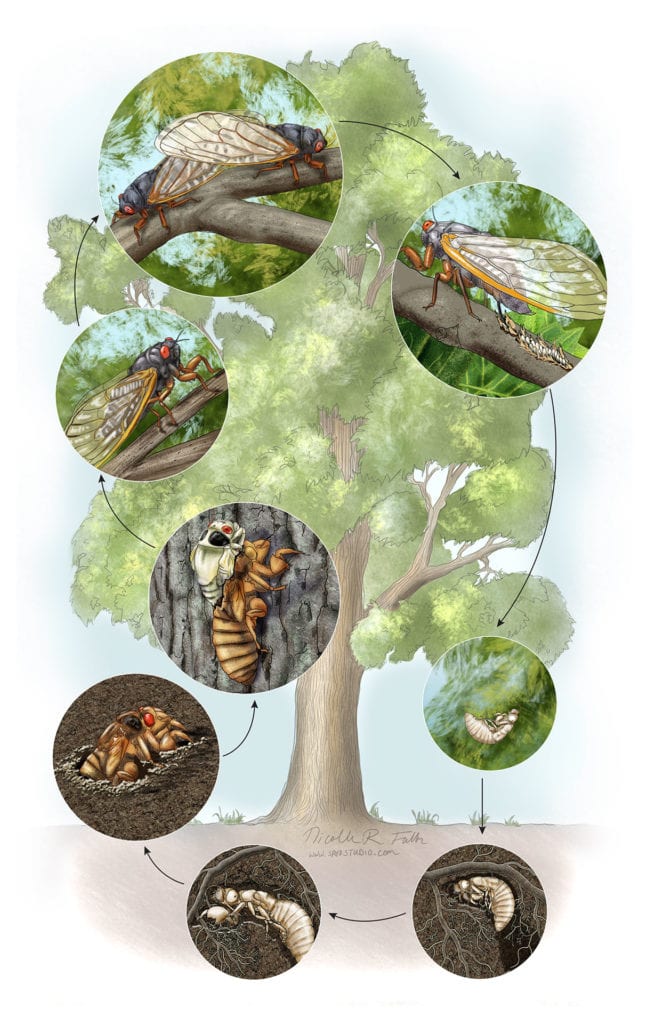They will come out in huge numbers after sunset and rapidly crawl to a. They spend almost their whole lives a foot or two underground living on sap from tree roots.

Brood X Cicadas Life Cycle Illustration Blog Sayostudio
The remaining broods emerge in 13.

. Broods I-XIV represent 17-year cicadas. Brood X has been underground in the Eastern US. The content includes the background life cycle damage and the management of the emergence of the Brood X Cicada in the vineyard.
Its not a long life so to speak but its a remarkable one. Prime numbers protect Brood X cicadas from everything but zombie fungus. All periodical cicadas of the same life cycle type that emerge in a given year are known collectively as a single brood or year-class.
The resulting broods are designated by Roman numerals there are 12 broods of 17-year cicadas with the remaining five year-classes apparently containing no cicadas and three broods of 13-year cicadas with ten empty year. Cicadas sing by vibrating part of their body called a tympanum. Simon 1988 and unpublished data.
TRILLIONS of Brood X cicadas are beginning to emerge but will only be around a few weeks. The insects then shed their exoskeletons on trees and other surfaces thus becoming adults. This Timely Viticulture article is on the periodical 17-year Brood X Cicadas.
Trillions of insects live underground for 17 years and all emerge at the same time for a few weeks mate and die shortly after. Plus learn live on. Brood X one of the broods of periodical cicadas that spends 17 years underground as nymphs began to emerge in the Eastern United States in May 2021.
The cicadas that emerge together in the same year are collectively called a brood. Quick Facts About Cicadas. Life cycle of a cicada Cicada nymphs emerge from the ground once the soil temperature has reached about 177C usually sometime in the middle of May.
These maps identify the approximate locations where each of the 15 present-day broods emerges. At the end of their life cycle female cicadas will lay eggs inside tree branches which will hatch and head back for the soil for another 17-year incubation. Periodical cicadas only emerge every 13 to 17 years a trick that may keep predators from adapting to the insect feast.
Every 17 years Brood X cicada nymphs tunnel upwards en masse to emerge from the surface of the ground. The song is meant to attract a mate. Oddly enough Brood X cicadas live for around 17 years or so as theyre born and die above ground just 17 years apart.
There are several different broods of the bugs across the United States. Then in the spring of their 13th or 17th year depending on the type mature cicada nymphs emerge for. The insects are gearing up to emerge from the ground after 17 years as soil temperatures across the US rise.
The lifespan of Brood X cicadas is 17 years from the time the eggs hatch and the nymphs burrow to the end of their life after they emerge and mate. Cicada mapping helps scientists verify the periodical insects life cycles as well as broods relationships to one another to gain a better understanding of. Illinois presents a particular challenge for understanding periodical cicada biology because it contains both 13 and 17 year life cycles all 7 currently recognized species and five separate broods some of which include disjunct populations.
Cicadas spend over 10 years underground and then they crawl out and hatch into the winged adult. Cicadas are one of natures strangest mysteries. The biggest cohort of them all Brood X is about to emerge in the US.
Then the 17-year cycle repeats. According to USA Today they usually come out in the spring mate lay eggs feed and die in late June or early July. The mature cicadas fly mate lay eggs in twigs and then die within several weeks.
Stannard 1975 published a map of all Illinois periodical cicada broods. By hatching out all at once Brood X cicadas overwhelm predators by sheer numbers. Brood X as opposed to Broods I through IX or Broods XIII and XIV each of which has a different emergence cycle of the 17-year periodical cicada line is.
The brood maps combine the data of C. The resulting broods are designated by Roman numerals there are 12 broods of 17-year cicadas with the remaining five year-classes apparently containing no cicadas and 3 broods of 13-year cicadas with ten empty year. Billions perhaps even close to a trillion cicadas will emerge as part of the 2021 emergence of Brood X 10.
These cicadas only have a lifespan of four to six weeks and will they will begin to die off from late June into July. All periodical cicadas of the same life cycle type that emerge in a given year are known collectively as a single brood or year-class.
17 Year Cicada Life Cycle The Washington Post


0 Comments